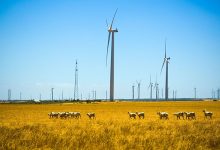Shifting Western Australia’s main electricity grid to 90 per cent renewables by 2030 is not only technically and economically feasible, but would create thousands of new jobs during an economic slump, a new report has found.
The report, put together by Sustainable Energy Now based on data from the Clean Energy Council and the Australian Industry Group, finds that moving W.A.’s South West Interconnected System, or SWIS, to 90% renewables by 2030 would generate 5,000 jobs a year on average.
Western Australia’s SWIS is the state’s main grid, which extends from Albany in the south, Kalbarri in the north and Kalgoorlie in the east, and includes the Perth metropolitan area. It is also completely independent to the National Electricity Market that connects Tasmania, South Australia and Australia’s eastern states.
The SEN report, which was commissioned by Clean State, assumes Western Australia’s SWIS would transition from one-third renewable by 2025 to 90% renewable by 2030, and 100% in the early 2030s – in line with Paris targets and modelling from Climate Analytics.
The state itself has no set renewable energy target, but the Labor McGowan government has an aspirational target of net-zero emissions by 2050 and – as W.A. energy minister Bill Johnston put it in May – no plan for any new energy generation beyond renewables.
Of course, a 90 per cent renewables by 2030 pathway will require a great deal more wind and solar energy infrastructure to be built across the state over a fairly short period of time, as well as more batteries and also pumped hydro to help provide grid stability.
“Construction work for new infrastructure projects has become an industry in itself,” said Ian Porter, the chairman of Sustainable Energy Now in a statement ahead of the report’s formal launch in Western Australia on Monday night.
“This report shows that transitioning to high levels of renewable energy creates a sustainable construction industry.”
According to the SEN report, moving the SWIS to 90% renewables by 2030 would create an average of 5,000 jobs per year between 2020-2030, and result in 8,600 full-time equivalent jobs in 2030, with 2,700 in ongoing operations and maintenance.
The other jobs created would be in engineering, design, planning, manufacturing, warehousing, transport, construction, installation, and decommissioning.
And the opportunity is the biggest where jobs are needed the most, with 50-60% of the job creation forecast to be located in regional areas.
“By transitioning to renewables Western Australia would create thousands of new jobs during an economic slump and make significant headway in achieving net-zero carbon emissions by 2050,” said Chantal Caruso, Clean State’s director of research and policy.
“In addition, breaking the link between energy and emissions will put Western Australia’s energy-intensive businesses at the forefront of the new low-carbon economy, giving them a competitive advantage,” she said.
The findings are backed by the largest study of current and projected employment in the renewable energy industry in Australia, conducted by the Institute for Sustainable Futures and the University of Technology Sydney for the Clean Energy Council and published in June.
The Clean Energy At Work report found that by 2025, small and big solar, wind energy, and energy storage projects could employ as many as 44,000 people – an almost doubling of the 25,000 the sector employs today – under the Australian Energy Market Operator’s favoured Step Change Scenario. More ambitious scenarios could result in even more jobs.










